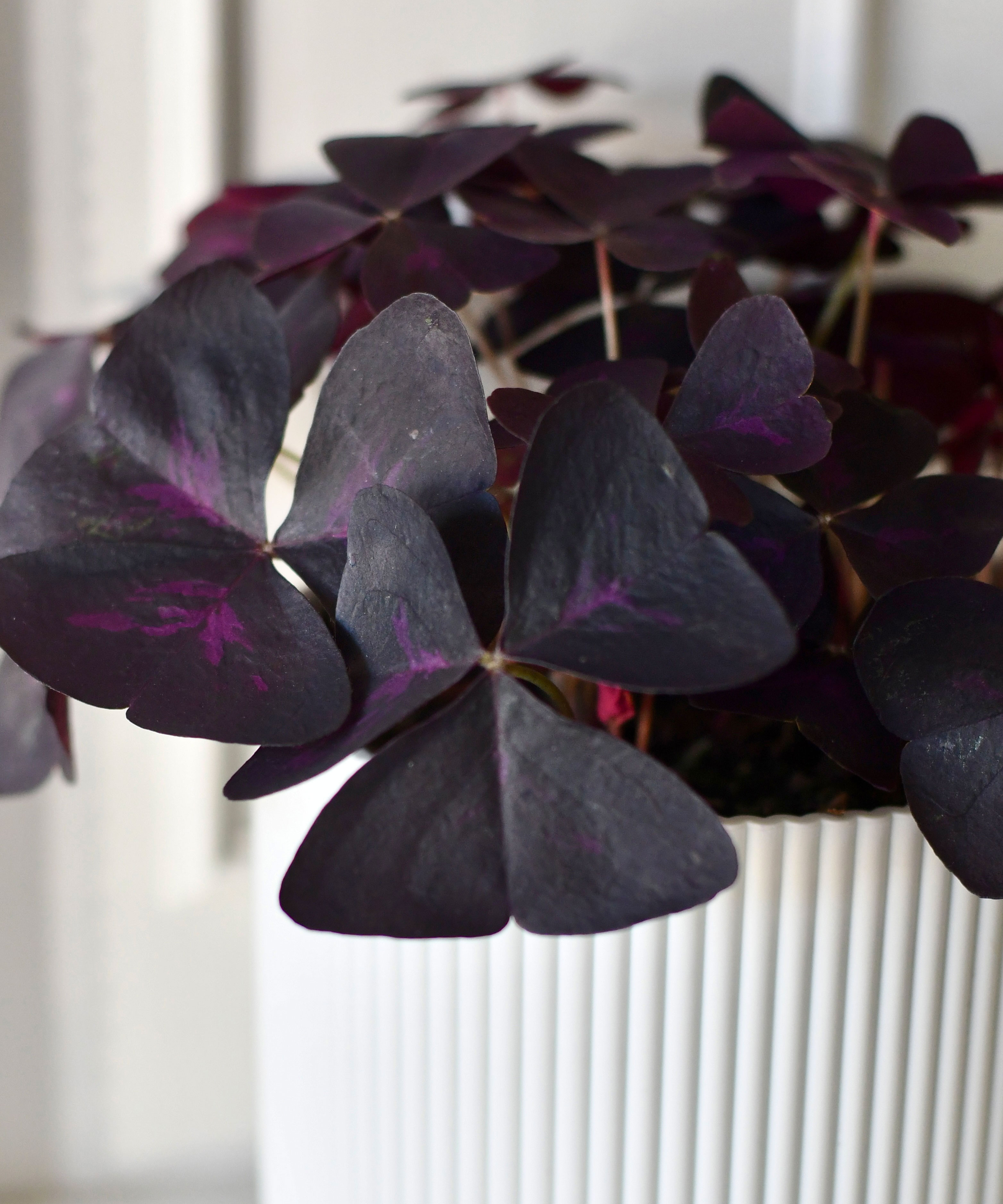How to grow and care for oxalis – expert tips for false shamrocks
Check out our experts’ tips to grow and keep your oxalis – or false shamrock – healthy all year round


Oxalis, or the false shamrock’s (Oxalis triangularis) dramatic dark purple leaves and sprays of starry white or pale pink flowers will make a striking statement in any houseplant collection.
You may find this plant listed as Oxalis regnellii and Oxalis triangularis ssp. papilionacea, but its common name refers to the three triangular leaflets that make up each leaf, which loosely resemble those of a shamrock or clover. However, this tropical beauty hails from South America, rather than the cool northern European climate enjoyed by its namesake.
While the unusual foliage is one of the best indoor plants to catch the eye, this little plant has another trick up its sleeve that makes it quite a talking point. As night falls, both the leaves and flowers fold up, opening again as the sun rises. Known as ‘nyctinasty’, this daily performance is thought to help the plant conserve moisture and keep its pollen dry when few pollinating insects are active.
Zen Landis, Sales Manager at Little Prince of Oregon Nursery, says that the iron cross plant or lucky clover (Oxalis tetraphylla ‘Iron Cross’) is another good choice for a houseplant. 'It makes a clump of bright green leaves with a dark burgundy cross in the center of its four leaflets,' he says. ‘And it’s a little hardier than the purple form.'
How to grow and care for oxalis

Zen Landis says that false shamrocks make good houseplants because they can thrive in containers for a long time before they need to be divided and repotted. 'The plants themselves stay relatively compact, too, making them a good choice for small spaces.'
Kelly Larson, Greenhouse Manager at Winter Greenhouse in Wisconsin loves these leafy plants for their colorful foliage, and recommends those with patterned leaves such as O. triangularis ‘Charmed Wine’ which sports pink markings.
Where to grow oxalis
'When grown indoors, I’d recommend placing them near a bright window without direct sun,' advises Zen. They also prefer cool conditions and may start to look tired or lackluster if temperatures exceed 80°F for any length of time.
Design expertise in your inbox – from inspiring decorating ideas and beautiful celebrity homes to practical gardening advice and shopping round-ups.
Because they don’t require high humidity, they will also thrive in most rooms in your house, including a living or dining room, or in the bedroom, if there is sufficient light.
How to water and feed oxalis
'Take care not to overwater oxalis and allow the soil to dry out completely between waterings,' explains Kelly. 'They also respond to regular feeding during the growing season. I recommend a balanced liquid fertilizer, applied every two to three weeks from spring to early fall.'
They won’t need feeding in winter when growth is slow or when they are dormant.
Kelly also says that plants may go dormant after flowering in summer, which will mean the stems and leaves die back. Do not panic if this happens, as it is just their natural resting period and they will start to grow again after a month or two.
The experts at New York Botanical Garden suggest keeping your plant in a cool dark place while dormant, and don’t water it until you see new shoots emerge. 'Resume regular watering and feeding when the plant begins to grow again,' adds Kelly.
Caring for oxalis
False shamrocks suffer from very few pests and diseases and are generally very easy to grow. Just take care not to overwater them, which may cause them to rot. To prevent this, make sure your plant is in a pot with drainage holes in the bottom (slip this inside a slightly larger watertight container or on a saucer to display it) and only water when the top layers of compost feel dry. Then water over a sink and leave the plant to drain before putting it back in its waterproof container.
When growing Oxalis outside, you may find slugs and snails nibble the foliage. If these pests are a problem, move your plant on to a table or to an area where it’s not so easy for them to reach it. Placing a layer of grit over the compost around the stems may help too.
FAQs
Can oxalis grow outdoors?
Kelly Larson says: 'We sell hardy Oxalis species that can be grown as garden plants in our Wisconsin climate, but houseplants such as Oxalis triangularis should be tucked up indoors until summer, unless you live in a warmer area where temperatures don’t dip below freezing, such as USDA climate zones 8a–11.'
After the frosts have passed, false shamrocks will enjoy a holiday outside in a sheltered, partly shaded area in your yard. Make sure they are in pots with drainage holes in the base when growing them outside to prevent waterlogging.
Do oxalis like to be misted?
Zen and Kelly both say that misting a false shamrock is not usually required. ‘These plants don’t need high humidity, but if your home is particularly dry or you live in an arid climate, you could place the pot on top of a shallow tray filled with pebbles and a little bit of water to increase the relative humidity around it,' says Zen.
False shamrock’s dark purple triangular leaves and small, starry flowers will create a colorful focal point in any bright room. Place your purple-leaved oxalis in a bright cool room, out of direct sunlight – they prefer temperatures of around 66–72°F, and pair them with their green-leaved cousins. The iron cross plant (Oxalis tetraphylla ‘Iron Cross’) is a beautiful form of oxalis, with bright green shamrock-like leaves decorated with a burgundy cross in the center.

Zia Allaway is a garden book author, editor, and journalist, and writes for a range of gardening and women’s magazines, including Easy Gardens, Homes & Gardens and Livingetc, as well as The Guardian and The Daily Telegraph newspapers. She has also written books for the Royal Horticultural Society and Dorling Kindersley publishers, including Eco-Gardening, Compost, Low Maintenance, Practical House Plant Book, Practical Cactus & Succulent Book, Indoor Edible Garden, What Plant Where, and the Encyclopedia of Plants and Flowers.